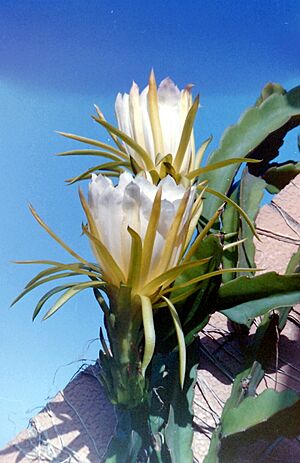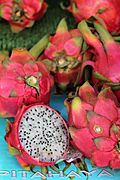White-fleshed pitahaya facts for kids
Quick facts for kids White-fleshed pitahaya |
|
|---|---|
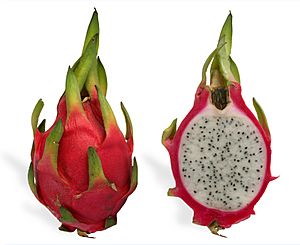 |
|
| Fruit | |
 |
|
| Scientific classification | |
| Genus: |
Selenicereus
|
| Species: |
undatus
|
| Synonyms | |
|
|
Selenicereus undatus, also known as the white-fleshed pitahaya or dragon fruit, is a type of cactus. It is the most commonly grown species in its group. People grow it for two main reasons: as a beautiful climbing plant and for its tasty fruit, the dragon fruit. We don't know exactly where this plant first came from.
Contents
What Does Dragon Fruit Look Like?
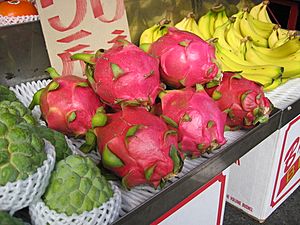
Dragon fruit plants have long stems that can climb, creep, or spread out. They branch a lot and can grow very long, from 5 to 10 meters (about 16 to 33 feet) or even more! Their stems are usually thick, about 10 to 12 centimeters (4 to 5 inches), and have three main ridges. As the plant gets older, the edges of these ridges become hard like horn and have a wavy shape.
Small bumps called areoles are found on the stems. These are where the spines or hairs grow on a cactus. On dragon fruit plants, these areoles are about 2 millimeters wide. The spines on older branches are short, only 1 to 4 millimeters long. They look like needles or small cones and are grayish-brown to black. The plant's skin is a deep green color.
The Flowers
The dragon fruit plant has large, beautiful flowers that open at night and smell nice. They are about 25 to 30 centimeters (10 to 12 inches) long and 15 to 17 centimeters (6 to 7 inches) wide. The outer petals are greenish-yellow or whitish, sometimes with a hint of pink. The inner petals are white and can be up to 15 centimeters (6 inches) long.
The flowers have many stamens (the parts that make pollen) that are 5 to 10 centimeters long and are a creamy color. The style (the part that receives pollen) is also creamy and can be very long, up to 24.5 centimeters. It has up to 26 stigma lobes, which are the parts that collect the pollen.
The Fruit
The fruit of the dragon fruit plant is shaped like an oval, about 6 to 12 centimeters (2.4 to 4.7 inches) long and 4 to 9 centimeters (1.6 to 3.5 inches) thick. It has a bright red skin with large, leaf-like parts called bracteoles. Inside, the fruit has white flesh filled with many small, edible black seeds.
Where Dragon Fruit Grows
Selenicereus undatus grows on rocks (lithophytic) or partly on other plants (hemiepiphytic). It is now grown in many tropical places around the world. Like all true cacti, this plant originally came from the Americas. However, we are not sure of the exact place where this specific dragon fruit species first appeared. It might even be a mix of different plants.
This cactus can grow on the ground or climb on trees and rocks using its aerial roots. It can reach heights of 10 meters (about 33 feet) or more!
About the Name
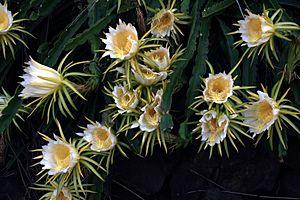
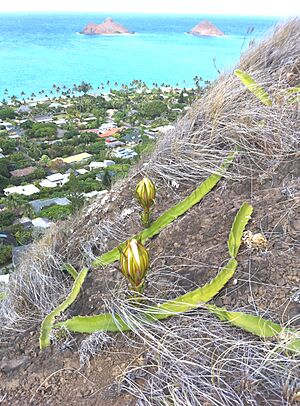
The scientific name Selenicereus undatus has a special meaning.
- Selene comes from a Greek word meaning 'moon'.
- Cereus comes from a Latin word meaning 'waxen' or 'waxy'.
- Undatus is a Latin word meaning 'wavy', which refers to the wavy edges of the plant's stems.
So, the name describes a 'wavy moon cactus', possibly because its flowers bloom at night.
Other Names for Dragon Fruit
Dragon fruit is known by many names around the world:
- English: pitahaya, dragon fruit, night blooming cereus, strawberry pear, Belle of the Night, Cinderella plant, Jesus in the cradle, moonflower
- Dansk: Dragefrugt
- Estonian: maasik-metskaktus
- Finnish: pitaija, lohikäärmehedelmä
- French: pitaya, fruit du dragon, cierge-lézard, poire de chardon
- German: Drachenfrucht, Distelbirne
- Greek: Φρούτο του δράκου (fruto tu draku)
- Hawaiian: panini-o-ka-puna-hou ("Punahou cactus") – a famous plant grows at Punahou School
- Japanese: pitaya (ピタヤ), dragon fruit (ドラゴンフルーツ)
- Korean: Yong-gwa (용과, 龍果, literally 'dragon fruit')
- Portuguese: pitaia, cato-barse, cardo-ananaz, rainha da noite
- Spanish: pitahaya roja (Costa Rica, Colombia, Mexico, Venezuela); flor de caliz, pitajava (Puerto Rico); junco, junco tapatio, pitahaya orejona, reina de la noche, tasajo (Mexico)
- Swedish: skogskaktus, röd pitahaya
- Vietnamese: thanh long
- Thai: แก้วมังกร (kaeo mangkon)
- Malay: buah naga (pronounced: boo-ah naa-gaa)
- Chinese: 火龙果, 火龍果; pinyin: huǒlóngguǒ
- Italian: Pitahaya, Frutto del Drago
- Bengali: ড্রাগন ফল (dragon fal)
- Lithuanian: kertuotis
- Myanmar: နဂါးမောက်သီး
See also
 In Spanish: Pitahaya roja para niños
In Spanish: Pitahaya roja para niños


